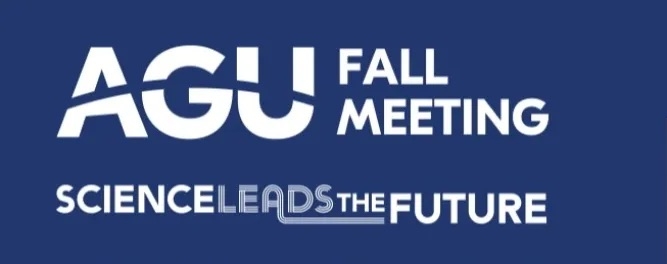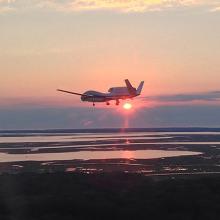The American Geophysical Union (AGU) Fall Meeting commences next week in Chicago, and IMPACT projects will be featured in 11 poster presentations from Monday, December 12 through Thursday, December 15. Be sure to stop by during the poster sessions to learn more about IMPACT’s newest developments and chat with team members about how they are supporting open science initiatives through their research and work.

Leveraging Assets for Better Decision-Making: the Satellite Needs Working Group
Monday, 12 December 2022 from 9:00 AM – 12:30 PM
In 2016, the U.S. Group on Earth Observations (USGEO) initiated the Satellite Needs Working Group (SNWG) to identify and communicate civil Earth observation needs of U.S. federal agencies. The SNWG identifies needs through a biennial survey and proceeds with interviews and follow-up discussions to identify solutions and services that leverage current or upcoming satellite missions, then NASA proposes services for funding. The process has resulted in implementing numerous services that have impacted U.S. agencies as well as academic and international institutions. The SNWG Management Office within IMPACT manages the implementation of selected solutions and NASA’s response to the needs of federal agencies through a Stakeholder Engagement Program. This presentation will further explain the processes managed by SNWG to facilitate high-level decisions regarding Earth observing satellite needs.
Fostering Open Science Through Public-Private Partnerships
Monday, 12 December 2022 from 9:00 AM – 12:30 PM
Remote sensing Earth observation data can greatly facilitate the work and responsibilities of various agencies within the U.S. government. However, navigating the myriad of remote sensing missions and making use of the ever-increasing remote sensing-based products and data are complex tasks that are outside of the scope of most agencies. NASA’s Satellite Needs Working Group (SNWG) formulates services and solutions that leverage current and upcoming satellite assets to address the remote sensing needs of U.S. agencies, and those needs are often identical to those of the broader remote sensing community. Hence, implemented services are highly relevant for a range of remote sensing data users. This presentation will explain how SNWG’s efforts to support Earth observing satellite programs encourages open science through collaboration between public agencies and private entities.
Promoting Open Science Through the Stakeholder Engagement Program
Monday, 12 December 2022 from 2:45 – 6:15 PM
Since 2016, the Satellite Needs Working Group (SNWG), an initiative of the U.S. Group on Earth Observations (USGEO), has surveyed federal agencies biennially to identify their satellite Earth observation needs. Coordinating with the agencies, NASA-led assessment teams work to identify solutions for each need. To enhance community engagement with new data products and technologies, the SNWG Management Office’s Stakeholder Engagement Program (SEP) was established. The SEP within IMPACT at Marshall Space Flight Center aims to increase awareness of the SNWG survey and its outcomes, support integration and use of SNWG solutions, and to enhance coordination among solution development teams, NASA’s Distributed Active Archive Centers (DAACs), SNWG stakeholders, and end user communities. This presentation will highlight SEP’s facilitation of open science goals in SNWG’s past, current, and future survey cycles.
Tuesday, 13 December 2022 from 9:00 AM –12:30 PM
NASA’s Biological and Physical Sciences division has generated a nucleic acid sequencing (DNA-seq, RNA-seq) dataset from space-flown experimental samples. The dataset is low in sample size but has a large number of genes contributing to the characteristics of the samples. This makes it difficult to identify the genes contributing to specific characteristics. In this work, we created an initial benchmark model. The dimension of the data was first reduced by clustering the genes based on their correlation with each other and selecting a representative gene. The representative genes were then used as inputs to train xgboost models. We then derived the genes most important to a given phenotype based on the trained model. In this presentation, we discuss the process and results from the benchmark models.
Benchmark Models for Classification of Radiation Type Induced in Immune Cells
Tuesday, 13 December 2022 from 9:00 AM – 12:30 PM
NASA Biological and Physical Sciences and the Science Mission Directorate has published a benchmark dataset of mouse immune cells that are subject to radiation-induced DNA damage. The dataset comprises ML-ready microscopic imagery of the cells, including labels indicating the applied radiation type. IMPACT created multiple benchmark models based on the dataset. Researchers conducted a preliminary analysis using thresholding, and machine learning approaches were also tested. Convolutional neural networks (CNN) emerged as the best performing model. In this presentation, we highlight and contextualize the benchmark scores obtained by the models.
Opening Historical Airborne Data to Present Day Researchers
Wednesday, 14 December 2022 from 9:00 AM – 12:30 PM
For more than 50 years, NASA has flown airborne sensors to carry out research, validate satellite sensors, and test new instrument capabilities. Prior to the year 2000, there was often no reliable way to publicly access these historical data products. These early media were often inaccessibly stored away in closets or warehouses. The NASA Airborne Data Management Group (ADMG) was formed in 2018 to improve the discoverability and accessibility of all NASA-funded airborne and field data. This presentation will share details of two recent data recovery successes by ADMG and the lessons learned while saving both ER-2 aircraft high-resolution photographs and DC-8 videos from destruction. The ADMG also facilitated assignment of both collections to a NASA DAAC and now guides tool development to enhance reuse of the data.
QuARC: Development of a Service to Enable FAIR-er Metadata
Wednesday, 14 December 2022 from 2:45 PM – 6:15 PM
Metadata quality is essential to effective data discovery and has become increasingly vital as Earth science datasets proliferate. The Common Metadata Repository (CMR) hosts metadata describing NASA’s Earth observation data products, archived across 12 Distributed Active Archive Centers (DAACs). The Analysis and Review of CMR (ARC) team conducts metadata quality assessments to ensure that these data products are discoverable, accessible, and usable. ARC has developed a host of scripts, known as pyQuARC, to automate metadata quality assessments as much as possible. pyQuARC utilizes ARC’s metadata quality assessment framework to make basic validation checks, pinpoint inconsistencies within information, and identify opportunities for more descriptive and robust information. This presentation will describe QuARC and highlight examples of its adoption for use cases outside of ARC. It will also present some preliminary metrics on how adopting QuARC has improved the team’s ability to conduct assessments.
Thursday, 15 December 2022 from 9:00 AM – 12:30 PM
Knowledge about the quality of data and associated metadata, software, workflows and computing environments is important to establish the trustworthiness of individual datasets. This knowledge supports informed decisions on data (re)use and is an essential part of the diverse information distribution ecosystem that supports open-source science. However, quality information is often not available for sharing within and across disciplines. To help address this challenge, and to promote the creation and (re)use of openly shared dataset quality information, members of multiple, international groups collaborating with domain experts have developed community guidelines with practical recommendations for the Earth science community. The guidelines follow the principles of being findable, accessible, interoperable, and reusable (FAIR). This presentation articulates the guidelines and how to apply them to make dataset quality information FAIR to all members of the AGU community.
Thursday, 15 December 2022 from 9:00 AM – 12:30 PM
Rapid advances in technology, along with increasing availability of data and information, are major drivers in accelerating the adoption of open science. Empowering cyberinfrastructures that leverage these technological advances is making science more efficient by enabling science at scale and fostering collaboration between scientists and organizations. While many organizations are taking advantage of this paradigm by moving data to the cloud, it is still a time of transition. Open science cyberinfrastructures must navigate this transitional period by looking for innovative approaches to enable access to data and empowering users to work with these data. In the presentation, we will describe the NASA Multi-Mission Algorithm and Analysis Platform (MAAP)’s approach to developing an open science data system that empowers scientists to conduct analyses at scale on the cloud.
Operationalizing Open Science through Agreements on Standards and Guidelines
Thursday, 15 December 2022 from 2:45 PM – 6:15 PM
The NASA Science Mission Directorate (SMD) is implementing a progressive information policy to facilitate open interdisciplinary science. The goal is to ensure widespread access to a broad range of NASA research results. Data repositories are often a nexus or connecting point in facilitating these collaborations and enabling policy compliance. NASA has begun to lay the groundwork for this infrastructure by establishing a core set of principles and an SMD-wide standards and guidelines process to help implement the NASA information policy. This presentation reviews the process, the development of initial guidelines and, most critically, the establishment of a community of practice across NASA’s 32+ scientific data repositories. The community is working to align divisional standards goals with broader SMD goals, determine which standards to adopt and how, and identify opportunities to create new standards.
A High Resolution Sea Ice Extent Product Derived From GNSS Reflected Grazing Angle
Thursday, 15 December 2022 from 2:45 PM – 6:15 PM
With the use of reflected navigation signals, Global Navigation Satellite Systems-Reflectometry (GNSS-R) provides novel observations over the Earth’s surface. Spire Global, Inc. has a constellation of radio occultation satellites capable of observing GNSS signals as they refract through the atmosphere or are reflected off the Earth’s surface. These signals provide information on features causing alterations to the GNSS signal. Processed GNSS-R grazing angle reflections provide novel observations of the cryosphere, notably the presence and thickness of sea ice. We use sea ice data products from the Spire GNSS constellation to demonstrate the ability to generate a sea ice extent product for long-term climate monitoring. This presentation further explains development of this data product and reports its accuracy compared to other sea ice products.


